Yingchaojie Feng
Don't Reinvent the Wheel: Efficient Instruction-Following Text Embedding based on Guided Space Transformation
May 30, 2025
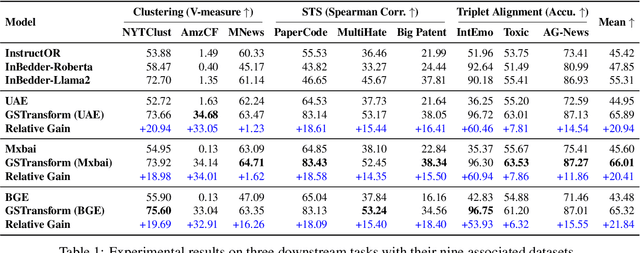
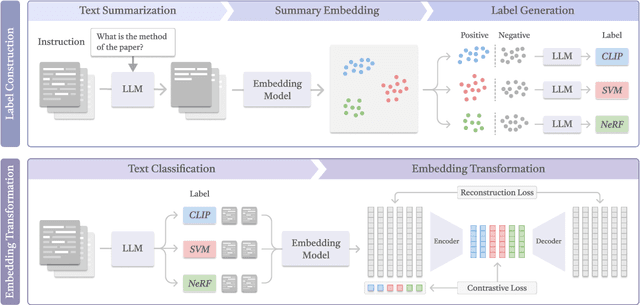

Abstract:In this work, we investigate an important task named instruction-following text embedding, which generates dynamic text embeddings that adapt to user instructions, highlighting specific attributes of text. Despite recent advancements, existing approaches suffer from significant computational overhead, as they require re-encoding the entire corpus for each new instruction. To address this challenge, we propose GSTransform, a novel instruction-following text embedding framework based on Guided Space Transformation. Our key observation is that instruction-relevant information is inherently encoded in generic embeddings but remains underutilized. Instead of repeatedly encoding the corpus for each instruction, GSTransform is a lightweight transformation mechanism that adapts pre-computed embeddings in real time to align with user instructions, guided by a small amount of text data with instruction-focused label annotation. We conduct extensive experiments on three instruction-awareness downstream tasks across nine real-world datasets, demonstrating that GSTransform improves instruction-following text embedding quality over state-of-the-art methods while achieving dramatic speedups of 6~300x in real-time processing on large-scale datasets. The source code is available at https://github.com/YingchaojieFeng/GSTransform.
DataLab: A Unified Platform for LLM-Powered Business Intelligence
Dec 04, 2024
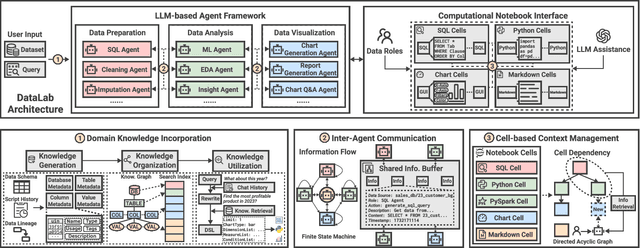

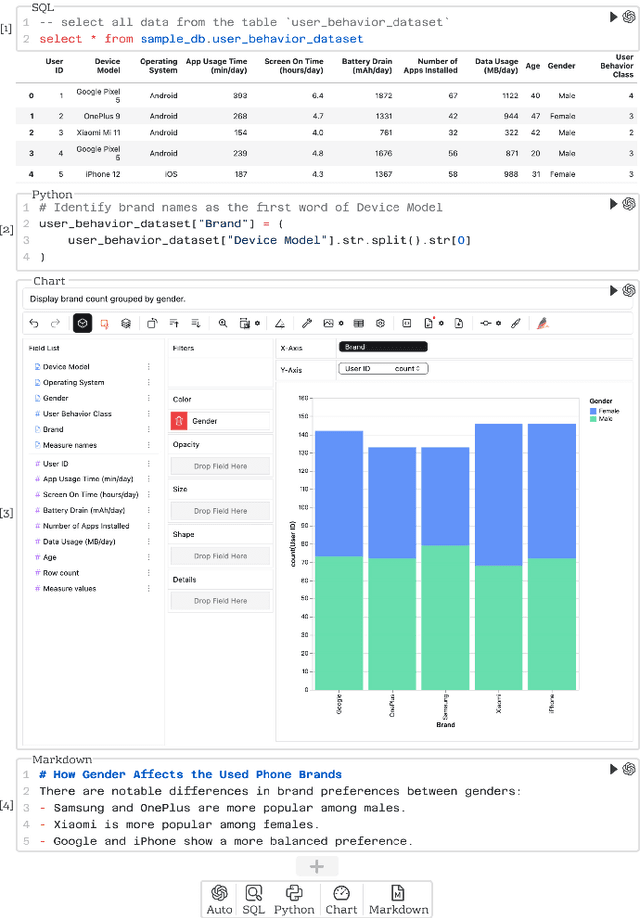
Abstract:Business intelligence (BI) transforms large volumes of data within modern organizations into actionable insights for informed decision-making. Recently, large language model (LLM)-based agents have streamlined the BI workflow by automatically performing task planning, reasoning, and actions in executable environments based on natural language (NL) queries. However, existing approaches primarily focus on individual BI tasks such as NL2SQL and NL2VIS. The fragmentation of tasks across different data roles and tools lead to inefficiencies and potential errors due to the iterative and collaborative nature of BI. In this paper, we introduce DataLab, a unified BI platform that integrates a one-stop LLM-based agent framework with an augmented computational notebook interface. DataLab supports a wide range of BI tasks for different data roles by seamlessly combining LLM assistance with user customization within a single environment. To achieve this unification, we design a domain knowledge incorporation module tailored for enterprise-specific BI tasks, an inter-agent communication mechanism to facilitate information sharing across the BI workflow, and a cell-based context management strategy to enhance context utilization efficiency in BI notebooks. Extensive experiments demonstrate that DataLab achieves state-of-the-art performance on various BI tasks across popular research benchmarks. Moreover, DataLab maintains high effectiveness and efficiency on real-world datasets from Tencent, achieving up to a 58.58% increase in accuracy and a 61.65% reduction in token cost on enterprise-specific BI tasks.
DataLab: A Unifed Platform for LLM-Powered Business Intelligence
Dec 03, 2024



Abstract:Business intelligence (BI) transforms large volumes of data within modern organizations into actionable insights for informed decision-making. Recently, large language model (LLM)-based agents have streamlined the BI workflow by automatically performing task planning, reasoning, and actions in executable environments based on natural language (NL) queries. However, existing approaches primarily focus on individual BI tasks such as NL2SQL and NL2VIS. The fragmentation of tasks across different data roles and tools lead to inefficiencies and potential errors due to the iterative and collaborative nature of BI. In this paper, we introduce DataLab, a unified BI platform that integrates a one-stop LLM-based agent framework with an augmented computational notebook interface. DataLab supports a wide range of BI tasks for different data roles by seamlessly combining LLM assistance with user customization within a single environment. To achieve this unification, we design a domain knowledge incorporation module tailored for enterprise-specific BI tasks, an inter-agent communication mechanism to facilitate information sharing across the BI workflow, and a cell-based context management strategy to enhance context utilization efficiency in BI notebooks. Extensive experiments demonstrate that DataLab achieves state-of-the-art performance on various BI tasks across popular research benchmarks. Moreover, DataLab maintains high effectiveness and efficiency on real-world datasets from Tencent, achieving up to a 58.58% increase in accuracy and a 61.65% reduction in token cost on enterprise-specific BI tasks.
JailbreakLens: Visual Analysis of Jailbreak Attacks Against Large Language Models
Apr 12, 2024
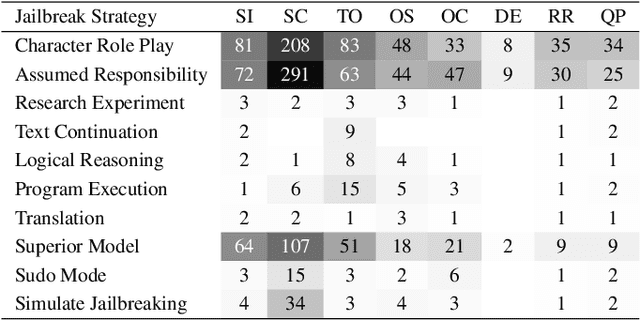


Abstract:The proliferation of large language models (LLMs) has underscored concerns regarding their security vulnerabilities, notably against jailbreak attacks, where adversaries design jailbreak prompts to circumvent safety mechanisms for potential misuse. Addressing these concerns necessitates a comprehensive analysis of jailbreak prompts to evaluate LLMs' defensive capabilities and identify potential weaknesses. However, the complexity of evaluating jailbreak performance and understanding prompt characteristics makes this analysis laborious. We collaborate with domain experts to characterize problems and propose an LLM-assisted framework to streamline the analysis process. It provides automatic jailbreak assessment to facilitate performance evaluation and support analysis of components and keywords in prompts. Based on the framework, we design JailbreakLens, a visual analysis system that enables users to explore the jailbreak performance against the target model, conduct multi-level analysis of prompt characteristics, and refine prompt instances to verify findings. Through a case study, technical evaluations, and expert interviews, we demonstrate our system's effectiveness in helping users evaluate model security and identify model weaknesses.
AgentLens: Visual Analysis for Agent Behaviors in LLM-based Autonomous Systems
Feb 14, 2024Abstract:Recently, Large Language Model based Autonomous system(LLMAS) has gained great popularity for its potential to simulate complicated behaviors of human societies. One of its main challenges is to present and analyze the dynamic events evolution of LLMAS. In this work, we present a visualization approach to explore detailed statuses and agents' behavior within LLMAS. We propose a general pipeline that establishes a behavior structure from raw LLMAS execution events, leverages a behavior summarization algorithm to construct a hierarchical summary of the entire structure in terms of time sequence, and a cause trace method to mine the causal relationship between agent behaviors. We then develop AgentLens, a visual analysis system that leverages a hierarchical temporal visualization for illustrating the evolution of LLMAS, and supports users to interactively investigate details and causes of agents' behaviors. Two usage scenarios and a user study demonstrate the effectiveness and usability of our AgentLens.
Computational Approaches for Traditional Chinese Painting: From the "Six Principles of Painting" Perspective
Jul 26, 2023Abstract:Traditional Chinese Painting (TCP) is an invaluable cultural heritage resource and a unique visual art style. In recent years, increasing interest has been placed on digitalizing TCPs to preserve and revive the culture. The resulting digital copies have enabled the advancement of computational methods for structured and systematic understanding of TCPs. To explore this topic, we conducted an in-depth analysis of 92 pieces of literature. We examined the current use of computer technologies on TCPs from three perspectives, based on numerous conversations with specialists. First, in light of the "Six Principles of Painting" theory, we categorized the articles according to their research focus on artistic elements. Second, we created a four-stage framework to illustrate the purposes of TCP applications. Third, we summarized the popular computational techniques applied to TCPs. The framework also provides insights into potential applications and future prospects, with professional opinion. The list of surveyed publications and related information is available online at https://ca4tcp.com.
PromptMagician: Interactive Prompt Engineering for Text-to-Image Creation
Jul 18, 2023Abstract:Generative text-to-image models have gained great popularity among the public for their powerful capability to generate high-quality images based on natural language prompts. However, developing effective prompts for desired images can be challenging due to the complexity and ambiguity of natural language. This research proposes PromptMagician, a visual analysis system that helps users explore the image results and refine the input prompts. The backbone of our system is a prompt recommendation model that takes user prompts as input, retrieves similar prompt-image pairs from DiffusionDB, and identifies special (important and relevant) prompt keywords. To facilitate interactive prompt refinement, PromptMagician introduces a multi-level visualization for the cross-modal embedding of the retrieved images and recommended keywords, and supports users in specifying multiple criteria for personalized exploration. Two usage scenarios, a user study, and expert interviews demonstrate the effectiveness and usability of our system, suggesting it facilitates prompt engineering and improves the creativity support of the generative text-to-image model.
XNLI: Explaining and Diagnosing NLI-based Visual Data Analysis
Jan 25, 2023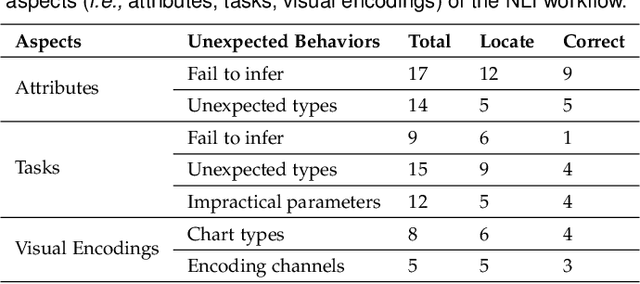

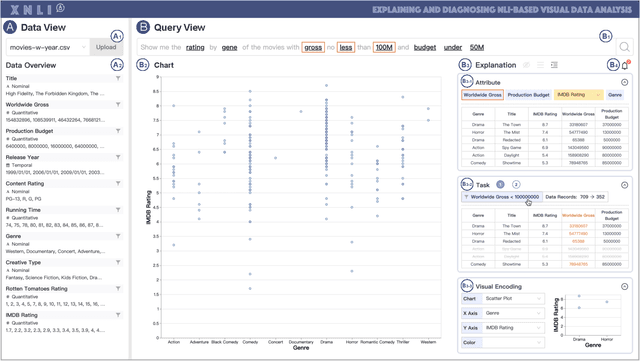

Abstract:Natural language interfaces (NLIs) enable users to flexibly specify analytical intentions in data visualization. However, diagnosing the visualization results without understanding the underlying generation process is challenging. Our research explores how to provide explanations for NLIs to help users locate the problems and further revise the queries. We present XNLI, an explainable NLI system for visual data analysis. The system introduces a Provenance Generator to reveal the detailed process of visual transformations, a suite of interactive widgets to support error adjustments, and a Hint Generator to provide query revision hints based on the analysis of user queries and interactions. Two usage scenarios of XNLI and a user study verify the effectiveness and usability of the system. Results suggest that XNLI can significantly enhance task accuracy without interrupting the NLI-based analysis process.
 Add to Chrome
Add to Chrome Add to Firefox
Add to Firefox Add to Edge
Add to Edge